
Congo may refer to either of two countries that border the Congo River in central Africa:
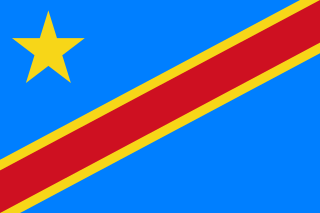
The Democratic Republic of the Congo (DRC), also known as Congo-Kinshasa, DR Congo, the DROC, or simply either Congo or the Congo, and historically Zaire, is a country in Central Africa. It is, by area, the largest country in sub-Saharan Africa, the second-largest in all of Africa, and the 11th-largest in the world. With a population of around 103 million, the Democratic Republic of the Congo is the most-populous officially Francophone country in the world, as well as the 2nd-most populous country in Africa, and the 13th-most populous country in the world. Since 2015, the Eastern DR Congo has been the scene of an ongoing military conflict in Kivu.

UTC+01:00 is an identifier for a time offset from UTC of +01:00. In ISO 8601, the associated time would be written as 2019-02-07T23:28:34+01:00. This time is used in:

The Republic of the Congo was a sovereign state in Central Africa, created with the independence of the Belgian Congo in 1960. From 1960 to 1966, the country was also known as Congo-Léopoldville to distinguish it from its northwestern neighbor, also called the Republic of the Congo, likewise known as Congo-Brazzaville. In 1964, the state's official name was changed to the Democratic Republic of the Congo, but the two countries continued to be distinguished by their capitals; with the renaming of Léopoldville as Kinshasa in 1966, it became also known as Congo-Kinshasa. After Joseph Désiré Mobutu, commander-in-chief of the national army, seized control of the country, it became the Republic of Zaire in 1971. It would again become the Democratic Republic of the Congo in 1997. The period between 1960 and 1965 is referred to as the First Congolese Republic.

Aethiopana is a genus of butterflies in the family Lycaenidae, endemic to the Afrotropical realm. The single species, Aethiopana honorius, the acraea blue, is found in Guinea, Sierra Leone, Liberia, Ivory Coast, Ghana, Togo, Nigeria, Cameroon, Gabon, the Republic of the Congo, the Democratic Republic of the Congo and Uganda. The habitat consists of forests.
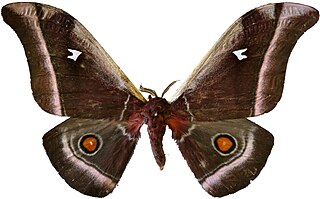
Bunaea alcinoe, the cabbage tree emperor moth, is an African moth species belonging to the family Saturniidae. It was first described by Caspar Stoll in 1780.

The Republic of the Congo, also known as Congo-Brazzaville, the Congo Republic or simply either Congo or the Congo is a country located in the western coast of Central Africa. To the west lies Gabon; Cameroon to its northwest and the Central African Republic to its northeast; the Democratic Republic of the Congo to the southeast and the Angolan exclave of Cabinda to its south; and the Atlantic Ocean to its southwest. The official language is French.

Lantanophaga pusillidactyla, the lantana plume moth, is a moth of the family Pterophoridae. It is native to the southern United States, Mexico, the Caribbean and South America. It was introduced to Australia accidentally in 1936 and is now found from Sydney to Cairns along the coast. It has also been introduced to Hawaii in 1902, Pohnpei in 1948 and Palau in 1960 for biological control. It has since been recorded from Yap in 1987–1988 and is now distributed on all islands of the Mariana and Caroline Islands where the host plant is found, except Aguijan.

Adaina microdactyla is a moth of the family Pterophoridae first described by Jacob Hübner in 1813. Also known as the hemp-agrimony plume, it is found in Africa, Asia and Europe.

Euphaedra zaddachii, or Zaddach's mimic forester, is a butterfly in the family Nymphalidae. It is found in Nigeria, Cameroon, Gabon, the Republic of the Congo, the Central African Republic, Angola, the Democratic Republic of the Congo, Uganda, Rwanda, Burundi, Kenya, Tanzania, Malawi and Zambia. The habitat consists of forests, including riparian forests and heavy woodland.
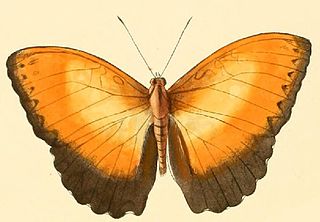
Cymothoe beckeri, or Becker's creamy yellow glider, is a butterfly in the family Nymphalidae. It is found in Nigeria, Cameroon, Gabon, the Republic of the Congo, Angola, the Democratic Republic of the Congo, the Central African Republic and Uganda. The habitat consists of forests.
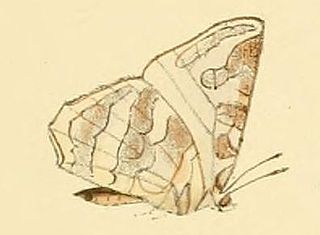
Euliphyra leucyania, the lesser moth butterfly, is a butterfly in the family Lycaenidae. It is found in Sierra Leone, Liberia, Ivory Coast, Ghana, Togo, southern Nigeria, Cameroon, Gabon, the Republic of the Congo, the Democratic Republic of the Congo (Sankuru), western Uganda and north-western Tanzania. The habitat consists of forests.

Telipna sanguinea, the sanguine telipna, is a butterfly in the family Lycaenidae. It is found in Nigeria, Cameroon, the Republic of the Congo, Equatorial Guinea, Gabon, Angola, the Central African Republic, the Democratic Republic of the Congo, Uganda and Tanzania. The habitat consists of forests.
Scopula internata is a moth of the family Geometridae. It is found in the Democratic Republic of Congo, Gambia, Kenya, Malawi, South Africa, Tanzania, Uganda and Zambia.
Afrasura obliterata is a moth of the subfamily Arctiinae. It is found in Angola, Cameroon, Chad, the Republic of Congo, the Democratic Republic of Congo, Gabon, Ghana, Kenya, Nigeria, Sierra Leone, South Africa, Togo and Uganda.
Creatonotos leucanioides is a moth of the family Erebidae. It was described by William Jacob Holland in 1893. It is found in Angola, Burkina Faso, Burundi, Cameroon, the Central African Republic, the Republic of the Congo, the Democratic Republic of the Congo, Ethiopia, Gabon, Ghana, Ivory Coast, Kenya, Liberia, Nigeria, Saudi Arabia, Sierra Leone, Sudan, Tanzania, the Gambia, Uganda, Yemen, and Zambia.
Mictocommosis argus is a species of moth of the family Tortricidae. It is found in Cameroon, Republic of Congo, Democratic Republic of Congo, Equatorial Guinea and Gabon.
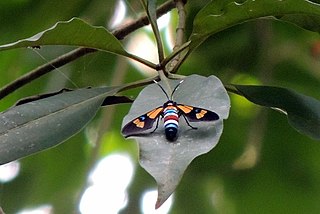
Euchromia lethe is a moth of the subfamily Arctiinae. It was described by Johan Christian Fabricius in 1775. It is found in Angola, Cameroon, the Republic of the Congo, the Democratic Republic of the Congo, Equatorial Guinea, Guinea-Bissau, Madagascar, Niger, Nigeria, Senegal, Sierra Leone, South Africa, São Tomé and Principe, the Gambia and Uganda.
Micralarctia punctulatum is a moth of the family Erebidae. It was described by Hans Daniel Johan Wallengren in 1860. It is found in Angola, Botswana, Cameroon, the Democratic Republic of the Congo, Eritrea, Ethiopia, Ghana, Kenya, Malawi, Mozambique, Namibia, Niger, Nigeria, Senegal, South Africa, Tanzania, Gambia, Uganda, Zambia and Zimbabwe.
Podomachla apicalis is a moth of the family Erebidae. It is found in Angola, Cameroon, the Republic of Congo, the Democratic Republic of Congo, Equatorial Guinea, Eritrea, Ethiopia, Gabon, Ghana, Kenya, Liberia, Malawi, Mozambique, Nigeria, Sierra Leone, South Africa, São Tomé & Principe, Tanzania, Togo and Uganda.













